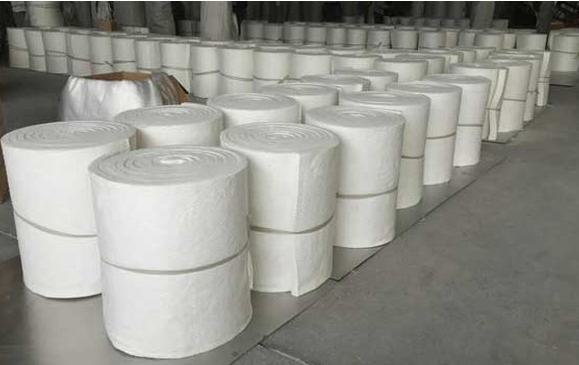- 26
- Sep
Aluminum silicate needle punched blanket
Aluminum silicate needle punched blanket

The aluminum silicate needle-punched blanket is a heat-insulating refractory heat-preserving material that uses aluminum silicate as the raw material and selects resistance furnace processing technology to specially make aluminum silicate long chemical fiber needle forming. The specially made aluminum silicate ceramic fiber polyester yarn is formed by the needle binding process. Improved the interlacing level, anti-layering characteristics, compressive strength and flatness of the surface layer of chemical fibers. The fiber blanket can contain all organic chemical bonding to ensure that the product has excellent manufacturability and reliability under high temperature and ultra-low temperature loads.
According to the different production process, it can be divided into silk spinning needle blanket and gas furnace needle blanket;
According to the different raw materials and secret recipes, it can be divided into: general type (STD), high purity type (HP), high aluminum type (HA), zirconium aluminum type, basic type, and zirconium-containing type (ZA).
Advantages of aluminum silicate needle punched blanket:
1. Fireproof material: heat-resistant 950-1400℃, flame-retardant grade and flame-retardant grade A, which can reasonably isolate the fire.
2. Thermal insulation: the well-proportioned and slender cotton fiber structure makes the heat transfer coefficient of the product lower, which in turn has the practical effect of thermal insulation.
3. Sound insulation: the microporous plate produced by the winding fibrous structure can reasonably weaken the refraction angle of the sound.
4. Anti-seismic grade: The structure of the microporous plate made of slim chemical fiber is soft and ductile, which can reasonably have the actual effect of anti-seismic grade.
5. Stability: The chemical molecules are not active and can be incorporated into various complicated structures.
The aluminum silicate needle-punched blanket is made of high-quality scorched gemstones that have been melted at a high temperature of about 2,000 yuan, and combined with other preservatives to condense. It has many unique characteristics, such as good ductility, strong durability, and light quality. It has excellent fire resistance, strong reliability, and does not deform under a high temperature of several thousand degrees. Therefore, aluminum silicate needle-punched blankets are often used in the chemical plant industry chain, construction industry, semiconductor industry, aerospace industry, military industry , Upholstered furniture and other industries.
Application of aluminum silicate needle punched blanket:
1. Industrial production of decorative building materials kilns, heating equipment, high-temperature pipeline wall linings.
2. The high temperature in the industrial production of chemical plants reflects the wall lining of machinery equipment and heaters.
3. Heat insulation and heat preservation pipes of electric power engineering heating furnace, steam turbine generator and nuclear power plant.
technical parameter:
| Standard | High purity type | Acupuncture | ||
| Classification temperature (℃) | 1260 | 1260 | 1360 | |
| Working temperature (℃) | 1050 | 1100 | 1200 | |
| colour | 洁白 | 洁白 | 洁白 | |
| Bulk density (kg/m3) | 260 320 |
260 320 |
260 320 |
|
| Permanent linear shrinkage (%) (body temperature for 24 hours, volume density 320kg/m3) | -3 (1000℃) |
-3 (1100℃) |
-3 (1200℃) |
|
| Thermal conductivity at each hot surface temperature (w/m.k) Bulk density 285kg/m3) | 0.085(400℃) 0.132(800℃) 0.180(1000℃) |
0.085(400℃) 0.132(800℃) 0.180(1000℃) |
0.085(400℃) 0.132(800℃) 0.180(1000℃) |
|
| Compressive strength (Mpa) (10% shrinkage in thickness direction) | 0.5 | 0.5 | 0.5 | |
| chemical components
(%) |
AL2O3 | 46 | 47-49 | 52-55 |
| AL2O3+SIO2 | 97 | 99 | 99 | |
| AL2O3+SIO2+Zro2 | – | – | – | |
| Zro2 | – | – | – | |
| Fe2O3 | <1.0< span=””> | 0.2 | 0.2 | |
| Na2O+K2O | ≤0.5 | 0.2 | 0.2 | |
| Product Size(mm) | usual format:600*400*10-5;900*600*20-50 Other specifications are made according to user requirements |
|||
